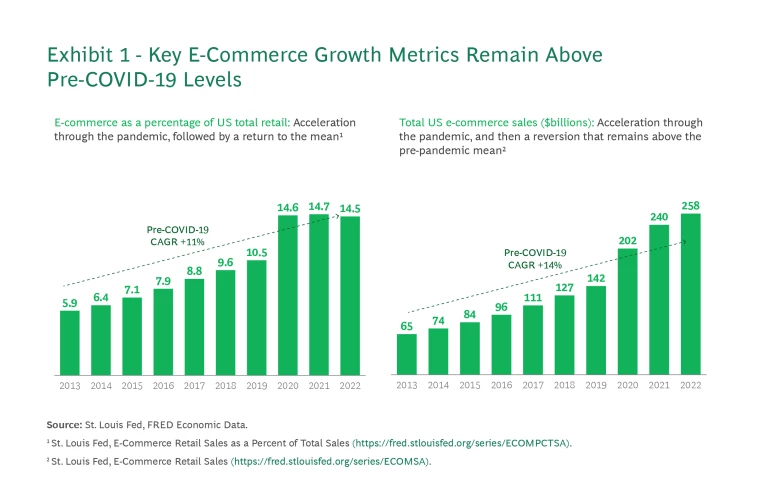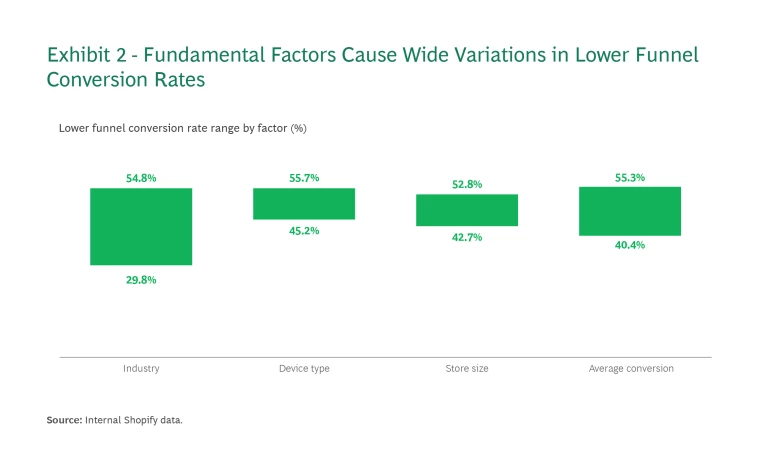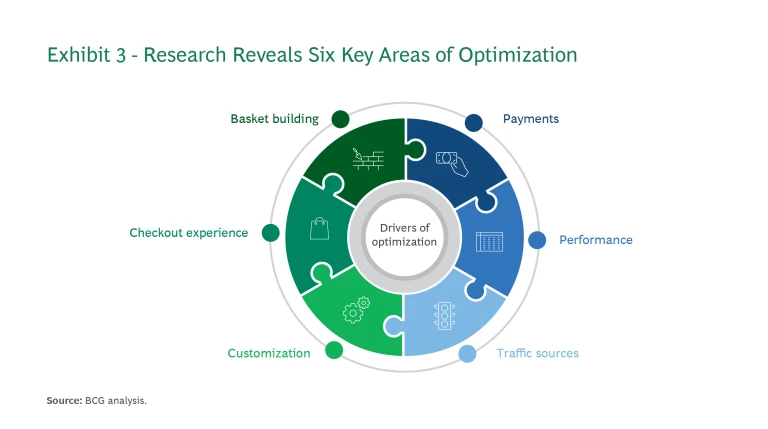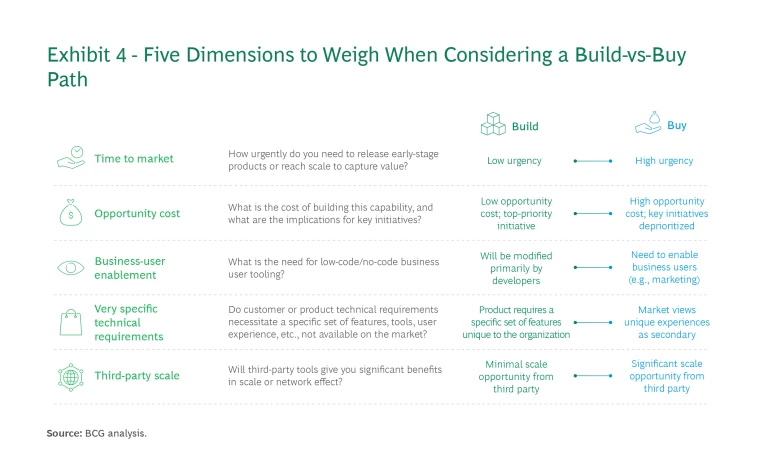E-commerce has grown in both volume and importance in recent years. When the COVID-19 pandemic hit, commerce of all kinds moved to digital platforms, and today online shopping activity remains well above its pre-pandemic levels. (See Exhibit 1.) Multiple sources invite shoppers to visit new e-commerce sites daily, and customers have grown to expect a seamless, tailored shopping experience across multiple channels and devices.

E-commerce sellers need to determine which customer requirements and technology enhancements can most effectively attract shoppers and motivate them to enter the checkout flow and complete the purchase. For this study, BCG and Shopify completed a comprehensive analysis of more than 220,000 e-commerce sites and more than 1 billion data points to examine the key drivers of the conversion process in which online shoppers become online buyers.
Although many particular factors affect conversion rates, they fall into two broad categories: factors that are fundamental to the store or business category itself (and therefore are not easy for sellers to change or control); and factors that are more amenable to sellers’ influence and optimization.
Fundamental variables include the seller’s industry, the type of device a customer uses, the seller’s store size, and the seller’s average conversion or average order value (AOV). (See Exhibit 2.)

In most e-commerce industries, the average overall funnel conversion rate—the rate of conversion at the last step, which commences when the customer begins the checkout process—ranges from 1% to 4%. The variations reflect, to a large extent, customers’ expectations and frame of mind when they click on a site. Potentially relevant factors include strong familiarity with the product, a social or word-of-mouth component, the product’s cost, and the typical time frame involved in deciding whether to purchase a product of a particular type.
Our research indicates that certain factors outside the seller’s control—including the seller’s industry and the device that the customer uses to browse the seller’s site—can have a noticeable impact on conversion. The conversion rate in certain industries, such as software and media, can be 200 to 300 basis points higher than in others, such as furniture and vehicles. Furthermore, customers are much more likely to complete their purchase when they shop from desktop devices.
Conversion rates at the lower funnel typically increase with stores’ overall revenue but decrease as AOV rises. The reasons likely have to do with product familiarity—which can drive increases for better-known, higher-revenue stores—along with the counterbalancing factor of the higher stakes involved when a consumer is considering a high-value purchase.

Although these factors are to some extent beyond the seller’s capacity to control, we identified six other major areas of conversion optimization that the seller can more directly influence (see Exhibit 3):
- Traffic Sources. Organic channels such as word-of-mouth or social media recommendations have a clear edge over paid channels in overall conversion rate, particularly for smaller sellers. Traffic that arrives through strategically deployed integrations linked to the site can also produce a higher conversion rate. A seller can set up external integration in many ways, including through social media, email marketing, customer reviews, and user experience integrations.
- Basket Building. Carts that contain more than five to ten items tend to yield demonstrably higher conversion. In fact, the conversion rate can increase by as much as 63% when a customer who initially puts just one or two units in the cart continues to shop and ends up with more than ten items.
- Checkout Experience. When a customer nears the checkout stage, any step that doesn’t work in a way that feels secure and convenient can be a deterrent. Return customers tend to appreciate autofill of known or easily predictable information such as shipping and billing addresses. Fraud detection, although essential to the customer’s peace of mind and security, should not impede the checkout flow. It is also wise to avoid forms that include blank coupon code fields, which can introduce elements of doubt.
- Accelerated Payments Methods. Our analysis found that offering accelerated payment methods such as Meta Pay, Amazon Pay, PayPal, Shop Pay, Apple Pay, and Google Pay can increase lower funnel conversion rates by upward of 50%.
- Customization. Generally, websites with front-end customization—such as a simplified user experience, obvious gateways to specific products, and an appealingly uncluttered product page—achieve higher conversion rates than those with back-end customization only. Customer loyalty programs tend to be particularly successful at increasing overall conversion rates, but sellers can also consider such customization options as tag manager tracking, analytics support, and targeted incentives to build a customer’s basket.
- Performance. Improved speed at every step correlates with higher conversion rates across most industries. At the lower funnel stage, customers will tolerate slightly slower performance on the way to completing a purchase—though only to a point. We have noticed a significant increase in the conversion rate, starting from the moment the checkout experience begins, when customers can complete the full checkout process in less than 90 seconds. If the process takes longer, the lower funnel conversion rate may decrease by around 47% on average.

Before planning a conversion strategy, an e-commerce seller must determine how the platform itself will support the shopping experience. Businesses of all sizes have the option of choosing an all-in-one commerce platform, versus developing everything in house, so that they can concentrate on the things they know best—the product, brand, and marketing—while relying on the technology provider to keep the engine up to date. (See Exhibit 4.) Continuous updating, of course, is crucial at a time when technology continually offers new ways to shop. The best e-commerce companies in the world adjust their technology quickly and optimize their offerings to meet their customers’ evolving needs. Our analysis shows that there can be a variance in conversion rate of as much as 36% from one all-in-one e-commerce platform to another, and that the overall conversion rate for e-commerce platforms outpaces the corresponding rate for custom-built options by nearly 10%.
Each seller’s game plan should reflect its products and its customer base. At the same time, several basic strategies have been effective in most sectors: driving loyalty; investing in personalization of the customer experience by remembering return customers at the checkout phase and providing a feedback loop; and investing in an innovative and well-engineered e-commerce platform.
Stay ahead with BCG insights on marketing and sales
Minor changes to the shopping experience can have a huge impact on a seller’s business and customers. For businesses of all sizes, it’s essential to regularly monitor the experience that the store is delivering to ensure that it meets the seller’s needs and the customer’s expectations.
This report is a collaboration between BCG and Shopify.








